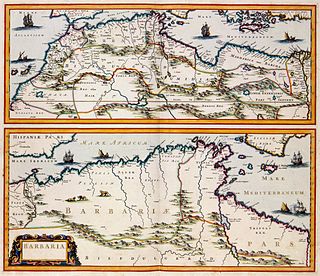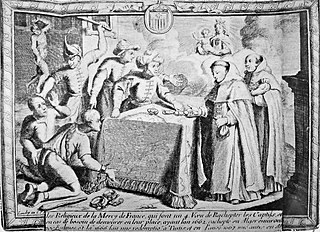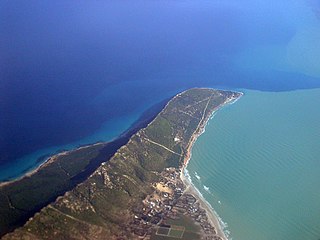Related Research Articles

The Barbary Coast was the name given to the coastal regions of central and western North Africa or more specifically the Maghreb and the Ottoman borderlands consisting of the regencies in Algiers, Tunis, and Tripoli, as well as the Sultanate of Morocco from the 16th to 19th centuries. The term originates from an exonym for the Berbers.

The Barbary pirates, Barbary corsairs, Ottoman corsairs, or naval mujahideen were mainly Muslim pirates and privateers who operated from the largely independent Barbary states. This area was known in Europe as the Barbary Coast, in reference to the Berbers. Slaves in Barbary could be of many ethnicities, and of many different religions, such as Christian, Jewish, or Muslim. Their predation extended throughout the Mediterranean, south along West Africa's Atlantic seaboard and into the North Atlantic as far north as Iceland, but they primarily operated in the western Mediterranean. In addition to seizing merchant ships, they engaged in razzias, raids on European coastal towns and villages, mainly in Italy, France, Spain, and Portugal, but also in the British Isles, and Iceland.

Occhiali was an Italian privateer and admiral who served as the commander of the Regency of Algiers and Grand Admiral of the Ottoman fleet.
John Ward, also known as Birdy or later as Yusuf Reis, was an English pirate who later became a Corsair for the Ottoman Empire operating out of Tunis during the early 17th century.

Ghar el-Melh, the classical Rusucmona and Castra Delia and colonial Porto Farina, is a town and former port on the southern side of Cape Farina in Bizerte Governorate, Tunisia.

The Beylik of Tunis was a de facto independent state located in present-day Tunisia, formally part of the Ottoman Empire. It was ruled by the Husainid dynasty from 1705 until the establishment of the French protectorate of Tunisia in 1881. The term beylik refers to the monarch, who was called the Bey of Tunis. Under the protectorate, the institution of the Beylik was retained nominally, with the Husainids remaining as largely symbolic sovereigns.

The French conquest of Tunisia occurred in two phases in 1881: the first consisting of the invasion and securing of the country before the signing of a treaty of protection, and the second consisting of the suppression of a rebellion. The French protectorate of Tunisia that was established lasted until the independence of Tunisia on 20 March 1956.

The Barbary slave trade involved the capture and selling of white European slaves at slave markets in the largely independent Ottoman Barbary states. European slaves were captured by Barbary pirates in slave raids on ships and by raids on coastal towns from Italy to Ireland, and the southwest of Britain, as far north as Iceland and into the Eastern Mediterranean.
The English ship Kentish was a 40-gun fourth-rate frigate of the Commonwealth of England Navy, built by contract at Deptford and launched in November 1652.

Siemen Danziger, better known by his anglicized names Zymen Danseker and Simon de Danser, was a 17th-century Dutch privateer and Barbary corsair based in Ottoman Algeria. His name is also written Danziker, Dansker, Dansa or Danser.

The Battle of Santa Cruz de Tenerife was a military operation in the Anglo-Spanish War (1654–60) which took place on 20 April 1657. An English fleet under Admiral Robert Blake penetrated the heavily defended harbour at Santa Cruz de Tenerife in the Spanish Canary Islands and attacked their treasure fleet. The treasure had already been landed and was safe but the English engaged the harbour forts and the Spanish ships, many of which were scuttled and the remainder burnt. Having achieved his aim, Blake withdrew without losing any ships.
Vice-Admiral Richard Badiley was an English naval officer. He saw service during the First Anglo-Dutch War.

Ottoman Tunisia, also known as the Regency of Tunis, refers to the Ottoman presence in Ifriqiya from the 16th to 19th centuries, when Tunis was officially integrated into the Ottoman Empire as the Eyalet of Tunis. The Ottoman presence in the Maghreb began with the takeover of Algiers in 1516 by the Ottoman Turkish corsair and beylerbey Aruj, eventually expanding across the entire region except for Morocco. The first Ottoman conquest of Tunis occurred in 1534 under the command of Khayr al-Din Barbarossa, the younger brother of Aruj, who was the Kapudan Pasha of the Ottoman Fleet during the reign of Suleiman the Magnificent. However, it was not until the final Ottoman reconquest of Tunis from Spain in 1574 that the Turks permanently acquired the former territories of Hafsid Tunisia, retaining it until the French occupation of Tunisia in 1881.
Usta Murad was a corsair captain and later Dey of Tunis from 1637 until his death.

Cape Farina is a headland in Bizerte Governorate, Tunisia. It forms the northwestern end of the Gulf of Tunis. The Tunisian towns of Ghar el-Melh, Rafraf, Lahmeri, and the beach of Plage Sidi Ali Mekki Est are located along the peninsula.

Until 1815 the Beylik of Tunis maintained a corsair navy to attack European shipping, raid coastal towns on the northern shores of the Mediterranean and defend against incursions from Algiers or Tripoli. After 1815 Tunis tried, with limited success, to create a modern navy, which fought in the Greek War of Independence and the Crimean War.
Amity was a 36-gun fourth rate vessel, formerly belonging to the Commonwealth of England. She was hired by Parliament in November 1649, and later purchased on 18 January 1650, thus renamed. She was commissioned into the Parliamentary Naval Force as Amity. During the First Anglo-Dutch War she partook in the Battle of Portland and the Battle of The Gabbard. Later, after the Restoration in May 1660, she was incorporated into the English Navy. During the Second Anglo-Dutch War she participated in the Battle of Lowestoft, the Four Days' Battle and the St James Day Fight. She was sold on 27 November 1667.
Success was a 38-gun fourth rate vessel captured from the French by the Commonwealth of England, She was captured on 19 October 1650 as the 38-gun Jules. She was commissioned into the Parliamentary Naval Force as Success. During the First Anglo-Dutch War she partook in the Battle of Portland and the Battle of Porto Farina. She spent time in the Mediterranean and escorting convoys. She was sold on 3 September 1662.
The English ship Merlin was a 14-gun sixth rate vessel built under the 1651 Programme at Chatham Dockyard for the Commonwealth of England in 1651/52. She sailed with Robert Blakes Fleet during her career in the Commonwealth Navy. She partook in the Battles of Portland, the Gabbard, Scheveningen and Porto Fina. She was incorporated into the Royal Navy as HMS Merlin in May 1660. She continued her duties in trade protection and convoy escort. She was taken by the Dutch off Cadiz, Spain defending her convoy in October 1665.

The Bombardment of Tripoli is a military operation of the Kingdom of France which took place between July 20 and July 27, 1728 against the current city of Tripoli, in Libya.
References
- ↑ Corbett, Julian Stafford (1904). England in the Mediterranean; a study of the rise and influence of British power within the Straits 1603-1713;. Cornell University Library. London, New York, Bombay Longmans, Green, and co.
- 1 2 "Blake in the Mediterranean 1654-5". bcw-project.org. Retrieved 6 April 2023.
- ↑ Corbett, Julian Stafford (1904). England in the Mediterranean; a study of the rise and influence of British power within the Straits 1603-1713;. Cornell University Library. London, New York, Bombay Longmans, Green, and co.
- ↑ Rodger, N. A. M. (2004). The Command of the Ocean: A Naval History of Britain, 1649 - 1815. Penguin. pp. 84–86. ISBN 978-0141026909.